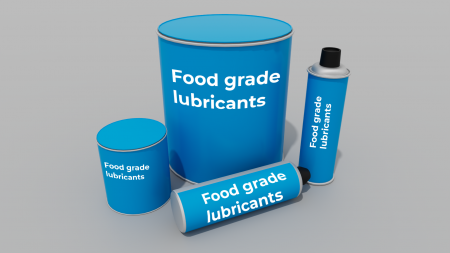This article discusses:
- Food-grade lubricants
- The recommendations for the raw materials of food-grade lubricants
The experts at Dinnissen Process Technology are available to answer all your questions:
Get in touch with Juul Jenneskens 077 467 3555
Food-grade lubricants
When designing a machine for the food industry, the designer must take into account that in addition to the processed food product, such as powder, other additives are also used in the machine. Think of substances such as grease and oil that are necessary for lubrication, heat dissipation, power transmission and corrosion protection of the machines. These types of aids should ideally not come into contact with the food product, but sporadic contact cannot be avoided. For that reason, special lubricants must be used. These are food-grade lubricants. These lubricants meet the requirements of health, safety and nutrition. When they do come into contact with the food product, they are not harmful to health. These food-grade lubricants have no negative effect on the taste and smell of the product. In addition, food-grade lubricants are also not subject to temporary chemical, thermal and mechanical pressure.
The exact definitions of food-grade lubricants can be found in various documents, such as USDA's H-1, and must adhere to the classification mentioned in that document. Definitions can also be found in DIN V 0010517 and NSF, a preliminary version of an ANSI standard. These definitions have been established by a qualified organisation and should not be deviated from.

Food-grade lubricants
Recommendations for the raw materials of food-grade lubricants
There are five recommendations for the raw materials of food-grade lubricants.
- In order to comply with the requirements of the FDA, there must be proof that the raw materials of the food-grade lubricant are pure by nature.
- 'Guaranteed Supplier Quality' is applied. This is a series of actions, such as inspections to ensure the quality and safety of the raw material supply.
- Samples must be taken systematically from the raw materials in order to guarantee quality.
- There must be a system that ensures that the raw materials of the food-grade lubricant are not contaminated. That system consists of two parts:
- periodic inventory checks. This should prevent contamination of raw materials that have been stored for a long time.
- Registration of batch data and a system that can recognize these batch numbers that are linked to raw materials.
- Finally, there must be a system that prevents unwanted materials from entering the production of food-grade lubricants.
It is not mandatory to use food grade lubricants on all lubrication points in the machine. The producer can make decisions about this himself. However, some food manufacturers do choose to use food-grade lubricants at all lubrication points to avoid confusion or mixing with non-food-grade lubricants. For lubrication points that are seen as a critical control point, it is in any case recommended to use food-grade lubricants.

Sampling device used to take samples to ensure quality
When they do come into contact with the food product, they are not harmful to health

Name: Juul Jenneskens
Advisor
Please feel free to contact me if you have any questions about this subject. My team of colleagues and I are ready to answer!
Get in touch with Juul Jenneskens 077 467 3555 [email protected]
Do you prefer to request a consultation directly?
